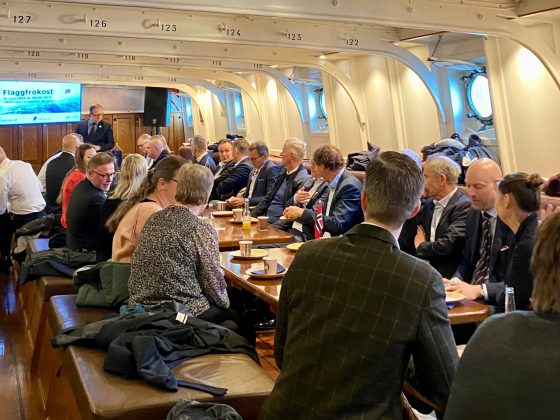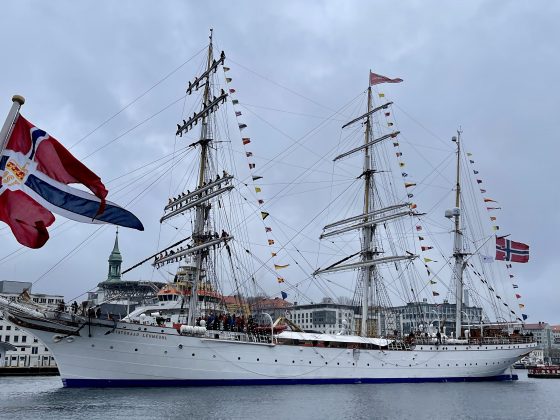The world might have come to a stop, but our collaboration towards Decarbonization of deep-sea shipping, has not. In our high-level webinar on April 22nd, Maritime Bergen and NCE Maritime CleanTech gathered profiled speakers to give an overview of the current situation in the shipping market, and the political drivers and measures from the IMO and EU.
Today, we are facing a surreal situation, which is unlike anything the world has seen since the WW2. The world has basically come to a complete stop, and the situation for the world economy is described as going into a situation that can be compared to the depression of the 1920s. The situation is confirmed with the prediction and outlook from IMF, where unfortunately Norway does not have the best predictions.
Still vessels will continue sailing the seven seas, transporting 90% of world trade by volume. Combined the world’s 50,000 vessels contribute to nearly 3% of global greenhouse emissions. The task at hand, according to national targets in Norway and goals set by IMO, is to reduce the greenhouse gas emissions with 50% within 2050. And as pointed out by Jutta Paulus from the European Parliament; “Covid-19 has not changed the urgency of the situation”.
Until now, no market-ready solution has been developed that will achieve the reduction targets. But we know that if no drastic actions are taken, CO2 emissions from international shipping could increase between 50 – 250% by 2050.
Decarbonization of deep-sea shipping and the Covid-19
Former president of Clarkson’s Research department, Dr. Martin Stopford has made an analysis on the correlation between decarbonization of deep-sea shipping and the Covid-19. His analysis is based on looking at the past to see if it helps predict the future – drawing parallels with the transition we in Norway underwent in the early 1900, going from sail to steam. This major transition was also done in a time where the world was beating off the Spanish flu and struggling survival of the great depression.
Dr. Martin Stopford started off by pointing out four elements we need to manage in the years ahead:
1) The impact of the corona virus pandemic on sea trade. It may turn out to be a catalysator.
2) Climate responding to global warming
3) The ships must get smarter with fewer resources ahead
4) Logistics ICT driven B2B trade.
Dr. Stopford continued by presenting three different scenarios in his analysis. The first scenario is the most optimistic one, where China would be back to work by summer of 2020 and Europe and USA would see an infection peak in April, and by the end of the year the economies would be working well. In this scenario the world growth takes a negative poll in 2020 and 2021 before it grows with an average of 3.2 percent.
The second scenario will imply problems of global supply and the trade growth of materials and goods would be weak in 2021, recovering briskly in 2022. This scenario sees the virus as persisting with infections re-occurring over the summer. Because of fiscal support businesses would be able to operate later in the year but it would not be business as usual. Not until 2023 the major G7 economies will be back onto an even keel. Sea trade does not really pick up until 2024.
The third scenario is a bit darker. One sees ongoing problems in China and by summer the lock-down becomes a major problem. By the end of the year governments face funding problems, and the shutdown eats into the overall economy. The problems will drag on for the next three years.
Dr. Martin Stopford also highlighted that the best way to commission new technology is to do it in waves. He presented three waves of investments of new technology at sea:
Wave 1: Design diesel vessels for slow speed by fine tuning energy and carbon, saving equipment to new IMO standards.
Wave 2: Develop low emission dual fuel and gas that leads to hybrid ships with batteries and advanced digital systems for short sea.
Wave 3: Evolve designs for zero carbon, all electric. When new power plants have been developed, ships will become available.
“We have had 30 years in shipping where things have not changed very much. Now we are going into 30 year where the changes will be similar of that when changing from wind to steam. Our task is to find a way forward that works both commercially and technically”, he said.
2050: What’s needed from the Shipping Industry to fulfil the IMO targets?
Sveinung Oftedal, Specialist Director in the Norwegian Ministry of Climate and Environment and Norwegian Head of Delegation to the International Maritime Organization (IMO), opened by saying that we are entering into a critical decade – this is the decade where the industry needs to create the solutions for the future. The governments’ responsibility is to create the framework needed for this work to succeed.
Throughout the different decades from the 1960’s and up until today we have had environmental challenges. We have established frameworks, implemented them, prevented accidents, and got to know challenges such as air pollution and lately climate changes. The world has become smaller in terms of closer interaction with one another and together we need to work towards zero because of the dramatic effects of the climate change.
IMO remains committed to their strategy on reducing GHG emissions and recognise the need to speed up and scale up in order to reach the goals.
“Looking into the future we have to bear in mind that various generation of ships will contribute to the overall carbon footprint. The question is; what generation of ships will be operating, and how much improvements must each generation of ships contribute with to achieve reduction ambitious”, Oftedal said. He also urged ship owners to be smart in their planning on new vessels.
“The ships that will be sailing in 2050 are designed today. To respond to future obligations, you need to plan for many years forward and make sure your ship will be built to meet future regulations”, he said.
EU pushing new emission targets ahead of IMO
From the European Parliament, Jutta Paulus is in lead of the ongoing EU political work regarding emission reductions from shipping activities. In the negotiations in Brussels, she addresses not only CO2 emissions but also methane, which is 87 times as powerful as CO2 in a 20-year time frame.
An important measure now discussed in Brussels is to EU-regulate ship efficiency and thereby “force” ship owners to optimize their loads. They to also discuss the introduction of an emission exchange systems for all ships visiting European ports. Paulus also presented the idea of an EU Maritime Decarbonisation Fund to support innovative solutions. Through the fund EU can raise several billion euros each year to trigger development and bringing technologies to scale.
In her presentation Paulus also enforced the customer’s role in the transition. The shift towards renewable fuels, such as hydrogen and hydrogen-based fuels, cannot be covered by stimulus packages and funds from the states alone. It also needs a creative strategy for how to engage customers in participating in paying the costs.
Paulus expressed that the EU is worried that IMO is not progressive enough in their goals. She feels that the IMO-processes takes too long, and that the 50 % target is not in line with the Paris agreement. With long experience from the broad consensus-driven IMO-work, Sveinung Oftedal replied: “IMO need to set targets that are seen the member states as possible to reach, 50 % is seen as ambitious. No one is doing enough at the moment, and more actions from IMO will come”, he said.
The European Parliament will discuss this maritime legislation package in June. And, as Paulus ended her talk to the Norwegian Shipowners gathered in the webinar: The Covid-19 crisis has not changed the urgency of the situation.
Collaboration towards low-carbon Deep Sea-solutions
The “Decarbonisation of deep-sea shipping” project gathers leading ship owners within different operational areas; Gearbulk, Utkilen, Wilhelmsen, Odfjell, Knutsen, Høegh and SinOceanic. The aim of the project is to map the status of different technologies, technology gaps and opportunities for innovation projects demonstrating new solutions that will allow the deep-sea sector to meet stricter regulations in the coming years.
By establishing this project, the partners are taking on the big task of defining how companies can cooperate on the transition of deep-sea towards low carbon. Through this project, we establish an environment where the partners can communicate openly and establish trust, as a critical and key success factor is to share experience and knowledge.




